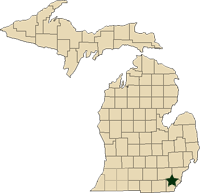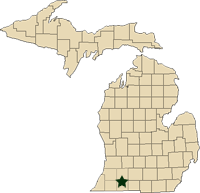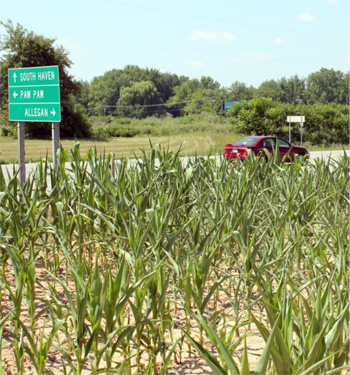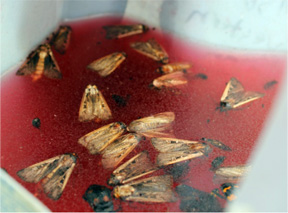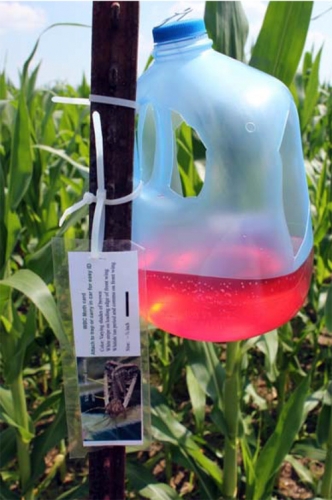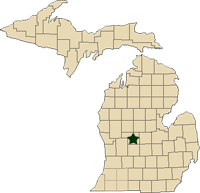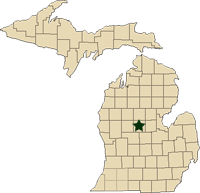Regional reports on Michigan field crops – July 14, 2011
MSU Extension educators’ pest and field crop updates for Michigan.
This week’s regional reports:
- Southeast Michigan – Ned Birkey
- Southwest Michigan – Bruce Mackellar
- West Central Michigan – Fred Springborn
- Central Michigan – Paul Gross
Southeast Michigan – Ned Birkey, Michigan State University Extension
|
Weather has been hot and dry, with the sole exception of rain last Monday (July 11). Even that rain was less than 1 inch. Otherwise, the region is about 4.5 inches short of rain since June 1. So far the region has had 15 days of 90°F temperatures; two days in May, six in June and seven in July. Fifteen days is the normal number for the entire season, with half of July and August yet to go this year.
Alfalfa second cutting is going on now, with generally very good quality and quantity. Potato leafhoppers are out and will be in the hay until the first fall frost.
Corn is highly variable, with the tassels just now coming out and yet some corn is barely above ankle height. Most corn is nearing the R1 growth stage. The extreme dry weather has shortened the leaf intermodal length and fields have had leaf rolling for over a week. We are between generations of European corn borers and traps have not caught any corn earworms. Western bean cutworm traps have caught up to 36 moths this week in the Monroe County location. Corn rootworms have also been feeding, though there are no silks for them to feed upon.
Oats have headed and are turning. Yields and test weights are expected to be light because of all the hot weather.
Soybeans are at the R1 bloom stage, with extremely variable height as well. Aphids are present at low levels, with more than 30 found in one field in Washtenaw County. Spider mites can also be found and I expect manganese deficiency symptoms to show up in fields with a soil pH of 7.0 or higher. The Conklin foliar fertilizer plots were sprayed last week in Monroe and Washtenaw counties and there remains high interest in foliar fertilizer of soybeans and wheat.
Wheat harvest is winding down and will be mostly finished this week. Yields have been average to above average, with good test weights. I have not heard of any vomitoxin problems. I have not seen any double crop soybeans being planted, but the high prices will encourage some farmers to do this even though it is the middle of July, with a very small window until fall.
Southwest Michigan – Bruce Mackellar, Michigan State University Extension
|
Weather
Sometimes a single weather event can have a significant foreshadowing effect on a whole growing season. So far, most of the region has received just enough rainfall (once the crops were up and growing) to keep production on track. But in late June, we had a series of rainfall events that moved just off the coast from north to south that provided huge amounts of precipitation over the southern Lake Michigan basin. Precipitation totals away from the coast and Berrien County were pretty light, ranging between 0.5 to 1 inches total from this persistent storm.
Hot and dry conditions followed the Fourth of July weekend. Many area fields experienced their first bought of drought stress during this season. This pattern was broken up by a severe line of thunderstorms on the morning of July 11 that caused significant damage. Straight line winds up to 85 miles per hour with reports of possible tornadoes and driving rains caused a lot of trees to fall on structures, widespread power outages and some crop damage, particularly to the area’s tart cherry crop, which was just about to be harvested.
Drought-stressed corn along M-43 in northern Van Buren County on July 8.
Rainfall totals reported by farmers from this storm ranged from 2.5 to 0.75 inches. Thankfully, there was not that much hail associated with this rapidly moving storm. We also seemed to escape this storm without a lot of center pivot irrigation system damage. Several fields of corn were blown almost flat in areas of the fields. Wheat fields that had lodged areas are mostly completely on the ground, particularly in Allegan County. Cool and dry conditions following a quiet passage of a cold front have been the situation over the last couple of days.
Temperatures
A quick look around the region shows that we are at 1053-1222 GDD’s Base 50 since May 1, depending upon the proximity to Lake Michigan, with an average of 1163 for the 12 Enviro-weather stations in the southwestern portion of the region. This is very close to the normal GDD accumulation levels. The average GDD accumulation Base 50 in the region for the next five days is 21.4 and the following five days is 22.2. The 6-10 day and 8-14 day outlooks have southwest Michigan solidly in the above normal temperature zone.
Rainfall
Rainfall totals since July 1 range between 0.85 inches in Cassopolis and 1.89 inches in South Haven. The average precipitation total for the 12 Enviro-weather stations during this period was 1.35 inches. Both the 6-10 and 8-14 day outlooks have southwest Michigan in the above normal precipitation range. We will keep our fingers crossed.
Wheat harvest progressed very quickly with the hot and dry conditions in the southern portion of the region. Yields have been pretty good, but test weight and kernel size was a little lower than expected. In areas to the northern portion of the region, harvest is just getting underway. Rain-laden wind lodged some wheat. Also, a fair amount of straw did get wet before it could be baled.
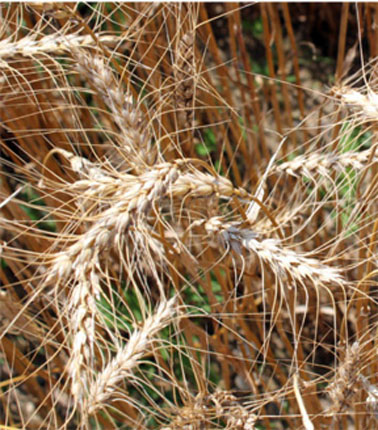
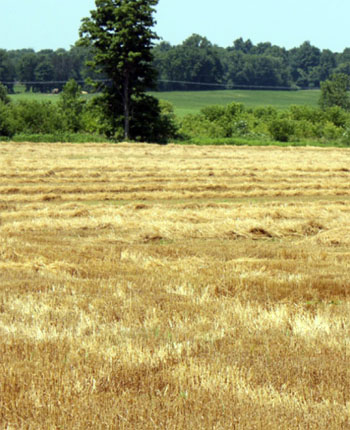
Alfalfa has been harvested pretty much on schedule for second cutting. Potato leafhopper numbers remain high. Remember, alfalfa regrowth thresholds for treatment are pretty low: two potato leafhoppers per sweep, 1- to 3-inch alfalfa. Even on more mature alfalfa, it is important to watch for signs of leafhopper feeding injury.
Corn. Early planted corn is at tassel emergence. The latest planted fields in the region are at the 5-leaf collar stage. Non-irrigated corn went through a slight to moderate drought-stress period prior to the recent thunderstorms. The hot and dry conditions occurred just as the early planted corn was ramping up evapotranspiration rate.
|
Western bean cutworm moth flight has seen a significant increase, up from one to two moths per night to seven to eight moths per night in some traps around Van Buren County. I have not seen egg masses yet, but egg deposition will likely begin soon with accelerated moth emergence. DiFonzo and her crew are busy monitoring western beat cutworm trap catch numbers around the state. Western corn rootworm beetles are emerging this week. Their numbers are fairly high. I have seen some evidence of goosenecking in fields, including some rotated soybean fields. I have also seen some evidence of leaf tissue feeding on rotated fields, suggesting that numbers of the “rotation-resistant” western corn rootworm variant are on the rise.
Corn water and nitrogen uptake will rapidly increase towards the maximum as we move into silking and early grainfill. Water usage will move to 0.22 to 0.28 inches per day of removal for optimal plant growth.
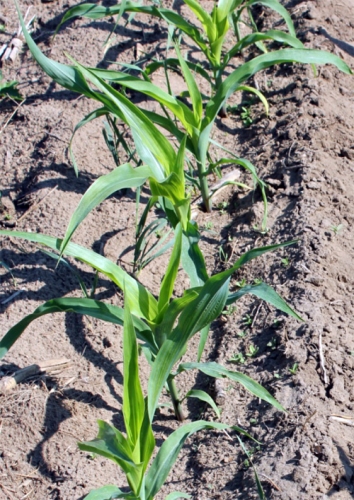
Corn planted around June 15 at the 4th leaf collar stage on
July 7 in Van Buren County.
Seed corn. Significant wind lodging of female rows of seed corn occurred on the July 11 storm. Greensnap was low from the event (less than 2 percent) in fields that I walked. While the corn is recovering, it can create challenges in differential plant height when it comes to de-tasseling.
Soybeans. Most soybeans are between R1 and early R3. Post-emergent applications of glyphosate should be coming to a close on the more advanced fields. Soybean aphid numbers are in decline, perhaps due to activity of predators in the field. You can find ladybird beetles in significant numbers in soybean fields in some areas. If we return to hot and dry conditions, I think that we should be on the lookout for spider mites. We had some serious drought-stress going on in soybean fields late last week, and this often sets the stage for spider mite numbers to establish a foothold in fields.
Western bean cutworm trap at the Cass County MSU Corn Variety Trial, hosted by the Cripes Family.
Japanese beetle numbers and associated damage are on the increase. The threshold for treatment for all types of soybean defoliators is 50 percent of leaf tissue damage in the vegetative growth stages, 25 percent at early pod fill. So far, soybeans have looked pretty good following the rainfall. I would encourage growers to be on the lookout for sudden death syndrome symptoms. Also, MSU soybean educator Mike Staton reminds us that this is an excellent time of year to look for soybean cyst nematode (SCN) damage in fields, and to evaluate the effectiveness of your varieties source of SCN resistance by looking for cysts on soybean roots.
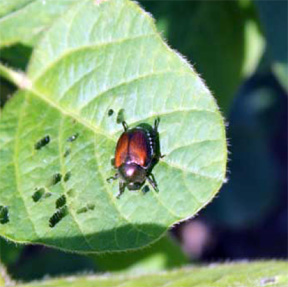
West Central Michigan – Fred Springborn, Michigan State University Extension
|
Light rain fell over much of the west central region on Monday (July 11) with most areas receiving 0.1 to 0.2 inches with some areas getting as much as 0.6. Temperatures have been very summerlike with highs in the 80s and approaching 90°F several days. Evapotranspiration rates have been quite high over the past week and many non-irrigated crops are starting to show signs of stress, especially on sandy, well-drained soils.
Wheat harvest has begun on a very limited basis as many fields still have areas that are not quite ready to thrash.
Early planted corn is close to tasseling. The flag leaf is emerging. June-planted corn is in the range of V4 to V7. In pheromone traps, very low numbers of European corn borer have been caught so far this season – two moths were caught in three traps last week. We are also starting to catch corn earworm moths in low numbers – two this week. Western bean cutworm moth catch is also fairly low, with most traps catching between five to eight in the last week.
Soybeans are beginning to blossom and most fields are at R1. Soybean aphids are present, but at very low numbers. Natural predator aphids are also present.
Dry beans are blossoming in early planted fields and are at various stages, down to first trifoliate in others. There are a few areas with significant root rot issues.
Pickles, like a lot of other crops, are variable. Downey mildew is present in Michigan. Growers are advised to follow MSU pathologist Mary Hausbeck’s fungicide recommendations and begin fungicide applications. Read her article, Downy mildew outbreaks in southeast Michigan on cucumbers, for more information. Tracking the progression of the disease across the state is helpful to your fellow growers. If you suspect downy mildew and we do not yet have a confirmation from your county, submit a sample to MSU Diagnostic Services for confirmation.
Alfalfa second cutting is underway. Continue to scout fields for potato leafhopper.
Central Michigan – Paul Gross, Michigan State University Extension
|
Weather
Scattered showers early in the week brought some relief from the dry conditions the region has been experiencing. The rainfall totals varied widely. The northern parts of the region received about a quarter inch, while areas of Clinton County received 2 inches. In addition, cooler temperatures are keeping the crop stress to a minimum on the heavier soils while moisture stress is evident on our course-textured soils. Rains will be needed in the near future to prevent yield loss.
Commodity reports
The corn crop ranges from knee high to tassels just emerging. The early planted corn looks excellent. The later planted fields are just now breaking out of some very slow, early growth and are beginning to catch up. There are no reported problems at this time. We are starting to catch small numbers of western bean cutworm in the traps, so moth flight is just getting started.
The soybean crop varies widely based on planting date. Early planted fields are blooming and nearly canopying in fields planted in rows. Soybean aphid populations remain low, but are present in nearly all fields. Continue to scout fields for these pests. There has been some sudden death syndrome tentatively identified in the southern parts of the region. Some root diseases have also been identified.
Wheat harvest is just getting underway in the southern parts of the region. Harvest is still a few days away in the north. The crop looks good and indications are that yield and quality will be good. White wheat growers are advised to be prepared to harvest as soon as possible to reduce the risk of quality issues.
Harvest of second cutting alfalfa is nearly complete. Many farmers are reporting very good yields and quality. Those that are trying to make dry hay are having good success with the dry weather. Scout fields for potato leafhoppers.
Dry beans are progressing after a slow start. Stands vary due to the excessive rains earlier. Scout fields for insect pests and monitor western bean cutworm moth trap catches in your area.
Oats and barley are beginning to turn. The barley looks like yields will be very good. Oats are also expected to yield very well.
Sugarbeets are all over the board. We have some very good stands and some very poor. The crop is in need of rain.



 Print
Print Email
Email